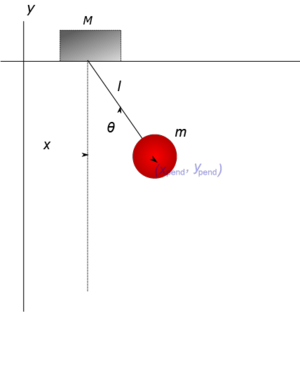Difference between revisions of "Matlab Primer"
| Line 13: | Line 13: | ||
See http://en.wikipedia.org/w/index.php?title=Lagrangian_mechanics&oldid=516894618 for a full derivation. | See http://en.wikipedia.org/w/index.php?title=Lagrangian_mechanics&oldid=516894618 for a full derivation. | ||
| + | |||
| + | Your homework and class exercise for today is to implement this model. I am going to show you how to do a simpler model with support fixed and unmovable. You can see what the equations for this are easily. Just plug in | ||
| + | |||
| + | :<math>\ddot x = \dot x = x = 0 </math> | ||
Revision as of 18:01, 3 November 2012
Today's lecture will be on MATLAB and PENDULA (plural of PENDULUM). Your next lab assignment motivated the topic.
My name is Sean Carver; I am a research scientist in Mechanical Engineering. I have been programming in MATLAB for almost 20 years and programming computers for almost 30 years.
This class is about MATLAB, not about deriving equations. So I am just going to give you the equations for the PENDULUM. There is still a lot to do to get it into MATLAB.
Pendulum on a movable support
This example comes from Wikipedia (copied legally). Consider a pendulum of mass m and length ℓ, which is attached to a support with mass M which can move along a line in the x-direction. Let x be the coordinate along the line of the support, and let us denote the position of the pendulum by the angle θ from the vertical.
See http://en.wikipedia.org/w/index.php?title=Lagrangian_mechanics&oldid=516894618 for a full derivation.
Your homework and class exercise for today is to implement this model. I am going to show you how to do a simpler model with support fixed and unmovable. You can see what the equations for this are easily. Just plug in


